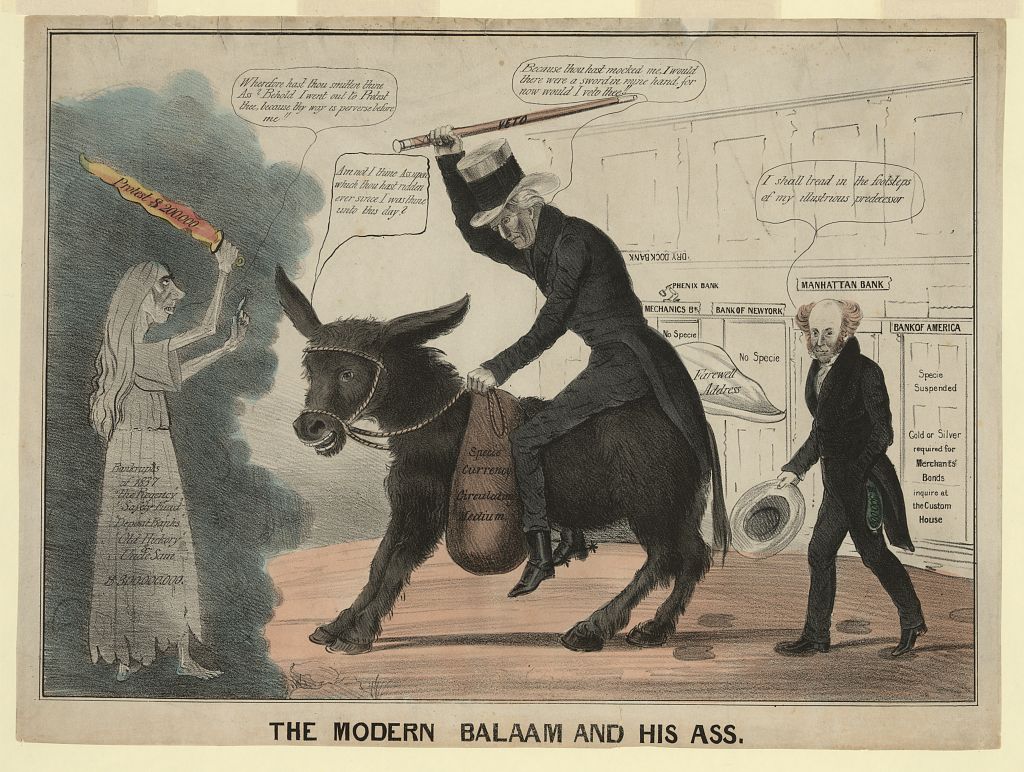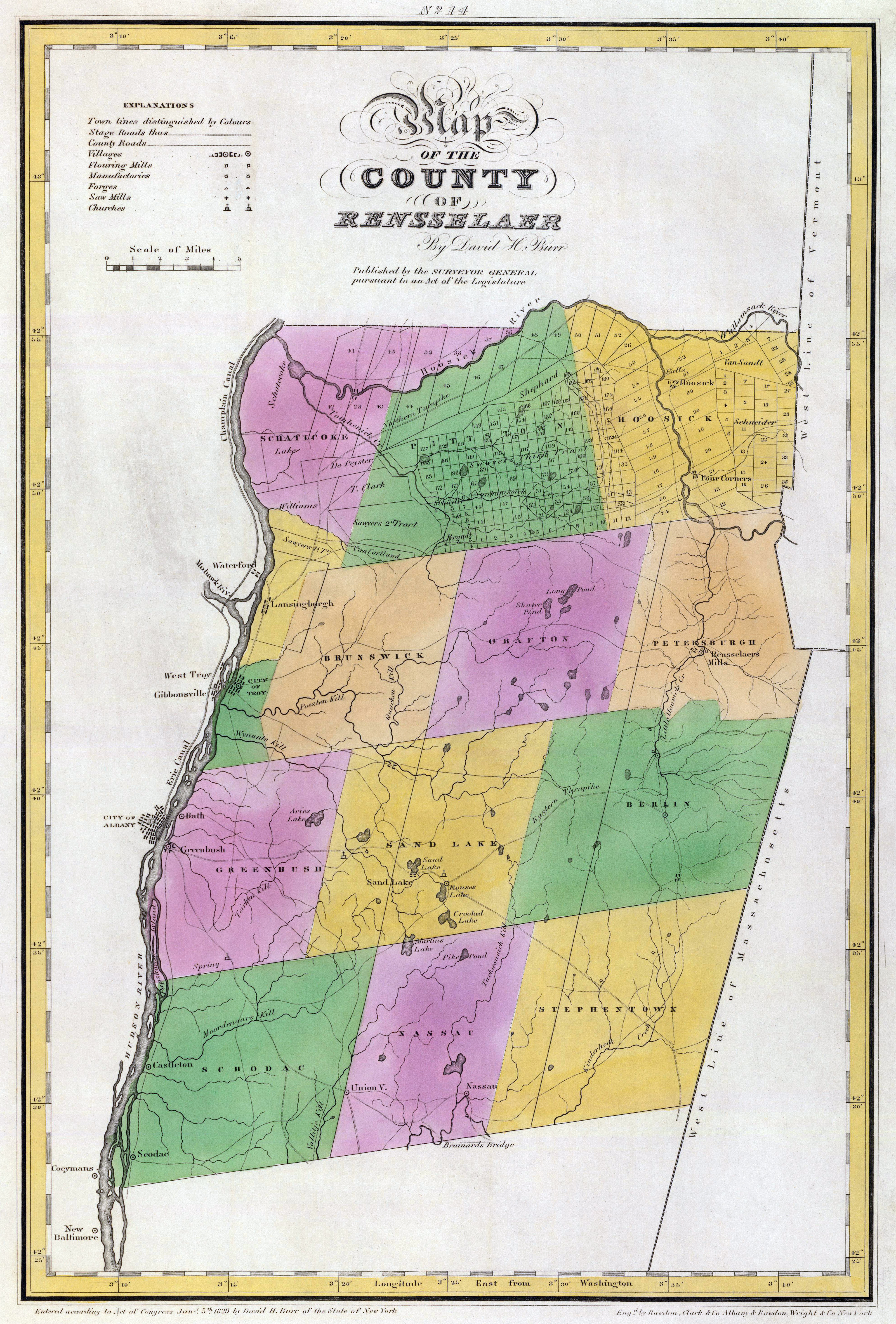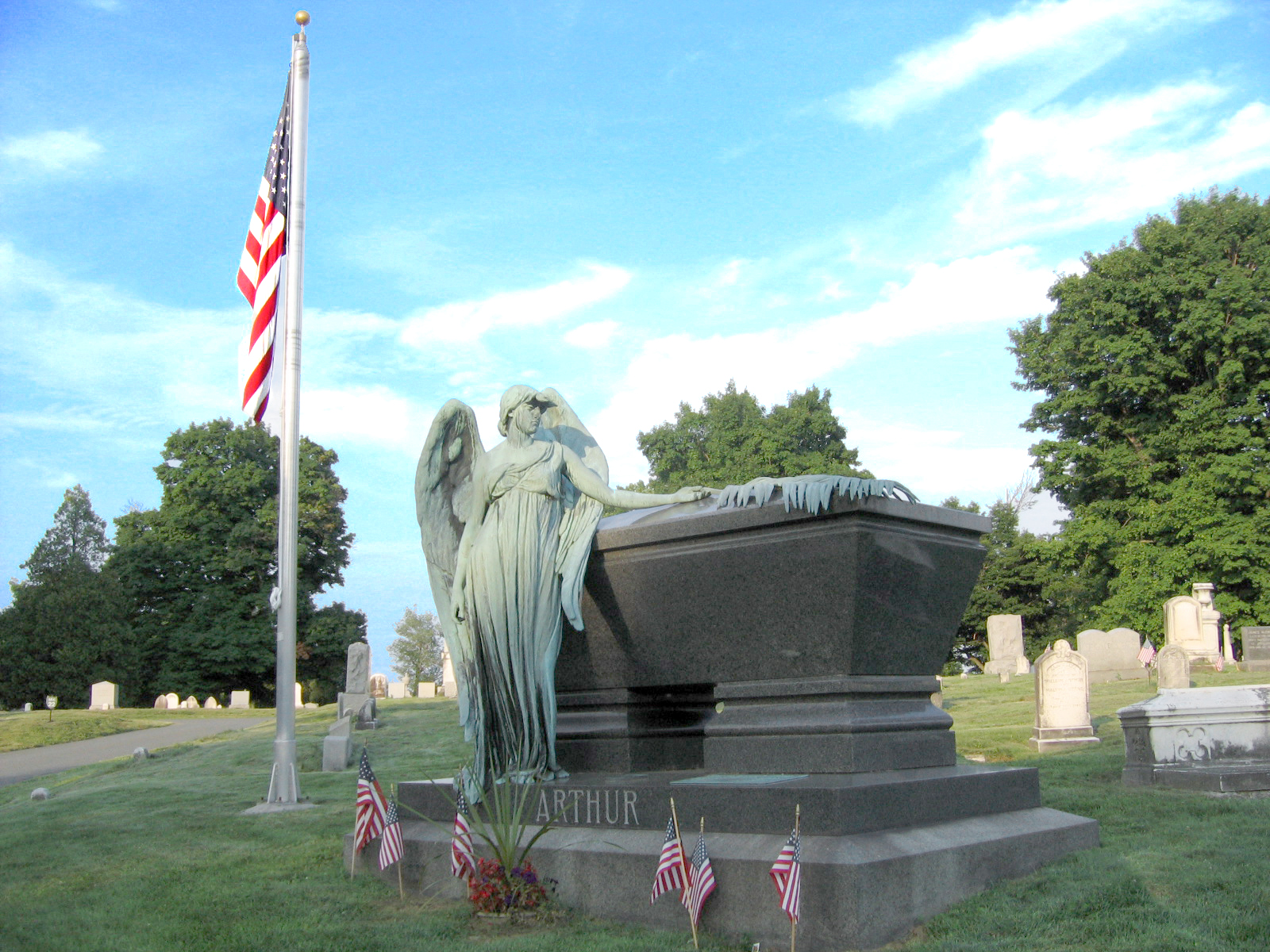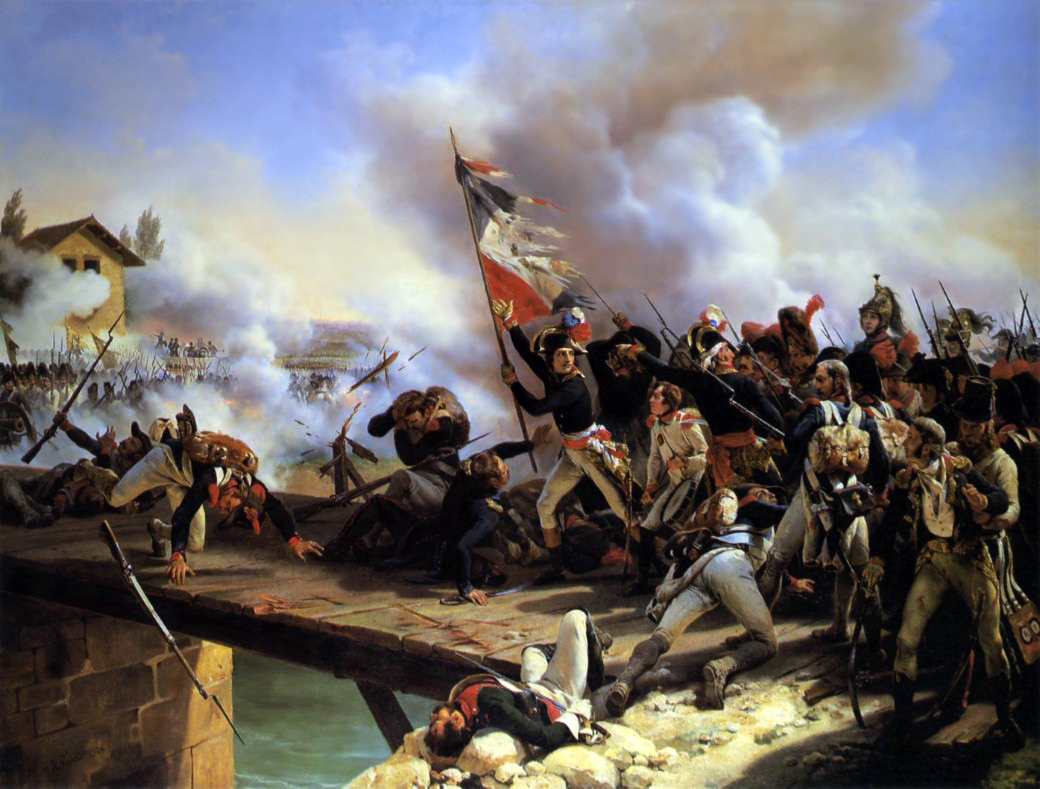|
Barent Staats
Barent Philip Staats (born September 25, 1796) was the mayor of Albany, New York. Staats ran as a Democrat and defeated John Townsend ( Whig) by 336 votes in 1842. The next year he doesn't run for reelection, and Friend Humphrey (Whig) defeated Peter Gansevoort by 226 votes. During the 57th New York State Legislature from January 1 – December 31, 1834 he was a Jacksonian Assemblyman. He was a doctor. Philip S. Staats, son of Joachim and Elizabeth (Schuyler) Staats, was born July 26, 1755 and married Annetje Van Alstyne (baptized January 13, 1762). He lived on Staats Island, Rensselaer County, and his fourth child was Barent P. Staats. Staats married Maria Gourlay. His second wife was Maria Ann Winne and his third wife was Caroline Porter. He is buried at Albany Rural Cemetery in Menands, New York Menands is a village in Albany County, New York, United States. The population was 3,990 at the 2010 census. The village is named after Louis Menand. The village lies inside the t ... [...More Info...] [...Related Items...] OR: [Wikipedia] [Google] [Baidu] |
Albany, New York
Albany ( ) is the capital of the U.S. state of New York, also the seat and largest city of Albany County. Albany is on the west bank of the Hudson River, about south of its confluence with the Mohawk River, and about north of New York City. The city is known for its architecture, commerce, culture, institutions of higher education, and rich history. It is the economic and cultural core of the Capital District of the State of New York, which comprises the Albany–Schenectady–Troy Metropolitan Statistical Area, including the nearby cities and suburbs of Troy, Schenectady, and Saratoga Springs. With an estimated population of 1.1 million in 2013, the Capital District is the third most populous metropolitan region in the state. As of 2020, Albany's population was 99,224. The Hudson River area was originally inhabited by Algonquian-speaking Mohican (Mahican), who called it ''Pempotowwuthut-Muhhcanneuw''. The area was settled by Dutch colonists who, in 1614, built Fort ... [...More Info...] [...Related Items...] OR: [Wikipedia] [Google] [Baidu] |
Whig (United States)
The Whig Party was a political party in the United States during the middle of the 19th century. Alongside the slightly larger Democratic Party, it was one of the two major parties in the United States between the late 1830s and the early 1850s as part of the Second Party System. Four presidents were affiliated with the Whig Party for at least part of their terms. Other prominent members of the Whig Party include Henry Clay, Daniel Webster, Rufus Choate, William Seward, John J. Crittenden, and John Quincy Adams. The Whig base of support was centered among entrepreneurs, professionals, planters, social reformers, devout Protestants, and the emerging urban middle class. It had much less backing from poor farmers and unskilled workers. The party was critical of Manifest Destiny, territorial expansion into Texas and the Southwest, and the Mexican-American War. It disliked strong presidential power as exhibited by Jackson and Polk, and preferred Congressional dominance in lawmaki ... [...More Info...] [...Related Items...] OR: [Wikipedia] [Google] [Baidu] |
Friend Humphrey
Friend Humphrey (March 8, 1787 – March 15, 1854) was an American merchant and politician from New York. Life He was born in Simsbury, Connecticut. In 1811, he moved to Albany, New York, where he engaged in the leather trade. He was a Whig member of the New York State Senate (3rd D.) in 1840 and 1841. He was Mayor of Albany from 1843 to 1845, and from 1849 to 1850. He died on March 15, 1854, in Albany, and was buried at the Albany Rural Cemetery in Menands, New York Menands is a village in Albany County, New York, United States. The population was 3,990 at the 2010 census. The village is named after Louis Menand. The village lies inside the town of Colonie and borders the northern city line of Albany. H .... Sources''The New York Civil List''compiled by Franklin Benjamin Hough (pages 132f, 142 and 425; Weed, Parsons and Co., 1858)of Public Officials buried at Albany Rural Cemetery {{DEFAULTSORT:Humphrey, Friend 1787 births 1854 deaths New York (state) ... [...More Info...] [...Related Items...] OR: [Wikipedia] [Google] [Baidu] |
57th New York State Legislature
The 57th New York State Legislature, consisting of the New York State Senate and the New York State Assembly, met from January 7 to May 6, 1834, during the second year of William L. Marcy's governorship, in Albany. Background Under the provisions of the New York Constitution of 1821, 32 Senators were elected on general tickets in eight senatorial districts for four-year terms. They were divided into four classes, and every year eight Senate seats came up for election. Assemblymen were elected countywide on general tickets to a one-year term, the whole Assembly being renewed annually. At the time of the state election in 1833, there were three political parties: the Jacksonian Democrats, the Anti-Masonic Party, and the National Republican Party. The latter two parties had formed an Anti-Jacksonian bloc at the previous election. Elections The State election was held from November 4 to 6, 1833. State Senators Thomas Armstrong (7th D.) and Albert H. Tracy (8th D.) were re-elect ... [...More Info...] [...Related Items...] OR: [Wikipedia] [Google] [Baidu] |
Jacksonian Democrats
Jacksonian democracy was a 19th-century political philosophy in the United States that expanded suffrage to most white men over the age of 21, and restructured a number of federal institutions. Originating with the seventh U.S. president, Andrew Jackson and his supporters, it became the nation's dominant political worldview for a generation. The term itself was in active use by the 1830s. This era, called the Jacksonian Era or Second Party System by historians and political scientists, lasted roughly from Jackson's 1828 election as president until slavery became the dominant issue with the passage of the Kansas–Nebraska Act in 1854 and the political repercussions of the American Civil War dramatically reshaped American politics. It emerged when the long-dominant Democratic-Republican Party became factionalized around the 1824 United States presidential election. Jackson's supporters began to form the modern Democratic Party. His political rivals John Quincy Adams and Henr ... [...More Info...] [...Related Items...] OR: [Wikipedia] [Google] [Baidu] |
Staats Island
Staats Island is an uninhabited island of the Beaver Island Group in the Falkland Islands. It lies between Beaver Island and Weddell Island, parallel to Tea Island and is in area. Wildlife The island is known for its Patagonian foxes and guanacos, both introduced species; the former is not to be confused with the closely related Falkland Islands fox now extinct. The introduction of guanaco has led to overgrazing of the tussac while the introduction of foxes has had a negative effect on the resident birds and there is an eradication programme to eliminate foxes from this and other islands in the Beaver Island Group The guanaco population, from 15 animals introduced in 1938-39, rapidly grew to around 275 by 1956, when culling began in order to replace them with sheep. By the early 1960s, they had been reduced to around 10-20 animals. The population oscillated between a few hundred and a few dozen, with repeated culling; as of 2004, the population had risen back to around 400 ... [...More Info...] [...Related Items...] OR: [Wikipedia] [Google] [Baidu] |
Rensselaer County
Rensselaer County is a county in the U.S. state of New York. As of the 2020 census, the population was 161,130. Its county seat is Troy. The county is named in honor of the family of Kiliaen van Rensselaer, the original Dutch owner of the land in the area. Rensselaer County is part of the Albany-Schenectady-Troy, NY Metropolitan Statistical Area. History The area that is now Rensselaer County was inhabited by the Algonquian-speaking Mohican Indian tribe at the time of European encounter. Kiliaen van Rensselaer, a Dutch jeweler and merchant, purchased the area in 1630 and incorporated it in his patroonship Rensselaerswyck. (It was part of the Dutch colony New Netherland). The land passed into English rule in 1664; the Dutch regained control in 1673, but the English took it back in 1674. Until 1776, the year of American independence, the county was under English or British control. The county was not organized as a legal entity until after the Revolution, in 1791, when ... [...More Info...] [...Related Items...] OR: [Wikipedia] [Google] [Baidu] |
Albany Rural Cemetery
The Albany Rural Cemetery was established October 7, 1844, in Colonie, New York, United States, just outside the city of Albany, New York. It is renowned as one of the most beautiful, pastoral cemeteries in the U.S., at over . Many historical American figures are buried there. ''Note:'' This includes an''Accompanying photographs''/ref> History On April 2, 1841, an association was formed to bring the cemetery into being. A committee of the association selected the site on April 20, 1844. The cemetery originally contained . This portion was consecrated October 7, 1844. Daniel D. Barnard delivered the dedication address, which was one of many given at rural cemeteries across the northeast in the years from Justice Joseph Story's address at Mount Auburn Cemetery in 1831 to Lincoln's Gettysburg Address in 1863. The first interment was made in May, 1845.Howell, George Rogers & Tenney, Jonathan (Eds.) (1886). Bi-centennial History of Albany: History of the County of Albany, N.Y., fro ... [...More Info...] [...Related Items...] OR: [Wikipedia] [Google] [Baidu] |
Menands, New York
Menands is a village in Albany County, New York, United States. The population was 3,990 at the 2010 census. The village is named after Louis Menand. The village lies inside the town of Colonie and borders the northern city line of Albany. History Menands would have been first spotted by Europeans ''circa'' 1609, when Henry Hudson dropped anchor somewhere near Cuyler or Pleasure Island during his voyage on the river later to be named after him. This would be the furthest north on the river that Hudson would go in the Half Moon. Today, those islands are connected to the mainland, and are the site of Interstate 787 exits 6 and 7, which includes the cloverleaf interchange with NY 378 and the Troy-Menands Bridge. Louis Menand settled in the village in 1842 and established an important horticultural business. He at first rented land that later became the Home for Aged Men, then in 1847 bought 11 acres of land where the Albany-Watervliet Turnpike (today Broadway) met the road g ... [...More Info...] [...Related Items...] OR: [Wikipedia] [Google] [Baidu] |
1796 Births
Events January–March * January 16 – The first Dutch (and general) elections are held for the National Assembly of the Batavian Republic. (The next Dutch general elections are held in 1888.) * February 1 – The capital of Upper Canada is moved from Newark to York. * February 9 – The Qianlong Emperor of China abdicates at age 84 to make way for his son, the Jiaqing Emperor. * February 15 – French Revolutionary Wars: The Invasion of Ceylon (1795) ends when Johan van Angelbeek, the Batavian governor of Ceylon, surrenders Colombo peacefully to British forces. * February 16 – The Kingdom of Great Britain is granted control of Ceylon by the Dutch. * February 29 – Ratifications of the Jay Treaty between Great Britain and the United States are officially exchanged, bringing it into effect.''Harper's Encyclopaedia of United States History from 458 A. D. to 1909'', ed. by Benson John Lossing and, Woodrow Wilson (Harper & Brothers, 191 ... [...More Info...] [...Related Items...] OR: [Wikipedia] [Google] [Baidu] |
Year Of Death Missing
A year or annus is the orbital period of a planetary body, for example, the Earth, moving in its orbit around the Sun. Due to the Earth's axial tilt, the course of a year sees the passing of the seasons, marked by change in weather, the hours of daylight, and, consequently, vegetation and soil fertility. In temperate and subpolar regions around the planet, four seasons are generally recognized: spring, summer, autumn and winter. In tropical and subtropical regions, several geographical sectors do not present defined seasons; but in the seasonal tropics, the annual wet and dry seasons are recognized and tracked. A calendar year is an approximation of the number of days of the Earth's orbital period, as counted in a given calendar. The Gregorian calendar, or modern calendar, presents its calendar year to be either a common year of 365 days or a leap year of 366 days, as do the Julian calendars. For the Gregorian calendar, the average length of the calendar year (the me ... [...More Info...] [...Related Items...] OR: [Wikipedia] [Google] [Baidu] |
Mayors Of Albany, New York
From its formal chartering on 22 July 1686 until 1779, the mayors of Albany, New York, were appointed by the royal governor of New York, per the provisions of the original city charter, issued by Governor Thomas Dongan Thomas Dongan, (pronounced "Dungan") 2nd Earl of Limerick (1634 – 14 December 1715), was a member of the Irish Parliament, Royalist military officer during the English Civil War, and Governor of the Province of New York. He is noted for hav .... From 1779 until 1839, mayors were chosen by the New York State's Council of Appointment, typically for a one-year term that began in September. From 1840 on, Albany's mayors were directly elected by the city's residents. Beginning in 1886, mayoral terms began on January 1 of the year after the mayor was elected. A total of 74 men and one woman have served as mayor since the city's inception; eighteen of them served multiple terms that were not consecutive. Erastus Corning 2nd served for over 40 years, longer than ... [...More Info...] [...Related Items...] OR: [Wikipedia] [Google] [Baidu] |







